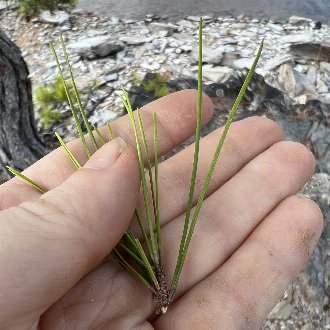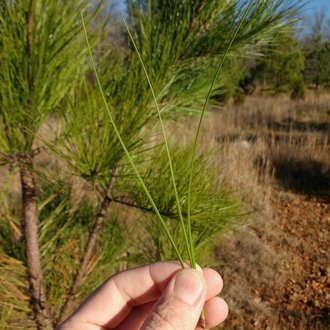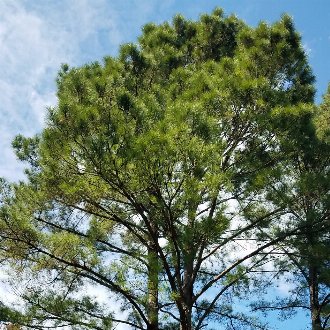Shortleaf Pine vs Loblolly Pine
These pines have a large area of range overlap, can occur in the same habitat, and are often confused. Both have red-brown bark with irregular rectangular plates. They can be distinguished by needle and cone length, presence of resin pockets in bark, and differences in form. P. echinata ranges farther north, is more common on dry uplands, and is more restricted to well-drained sites and leached, nutrient-poor soils with less competing vegetation. P. taeda is more common on moist bottomlands, prefers nutrient-rich soils where there is more competing vegetation, tolerates poorly-drained sites, and ranges farther south and slightly farther west.
Shortleaf Pine (Pinus echinata) | Loblolly Pine (Pinus taeda) |
A native pine of the southeastern US, growing as a pioneer species, preferring leached soils, more common on dry uplands but found in many conditions. | A pine native to the southeastern US, favoring moist bottomlands, also widely planted in forestry. |
Needles average much shorter (7-11cm, rarely 5-13cm) and usually occur in bundles of 2, sometimes 3. Photo © greensophie, CC BY 4.0. | Needles average much longer (12-18cm, rarely 10-23cm) and usually occur in bundles of 3, rarely 2. Photo © Ken-ichi Ueda, CC BY 4.0. |
Bark plates have resin pockets, which look like small circular pits. Photo © Laura Clark, CC BY 4.0. | Bark plates lack resin pockets. Photo © tentoedsloth, CC BY 4.0. |
Cones may be nearly sessile, but are usually on short stalks up to 1cm in length. Photo © Laura Clark, CC BY 4.0. | Cones are sessile (attached directly, without a separate stalk) or nearly so. Photo © Laura Clark, CC BY 4.0. |
Branches in crown often have a slight downward curve, ascending near the trunk, but flattening or even descending slightly towards the tips. Crown of mature trees averages more conical. Photo © Douglas Goldman, CC BY 4.0. | Branches in crown may curve down slightly, but more likely to ascend along their whole lengths, and may even curve up at the tips. Young trees have a sharply conical shape, but crown of mature trees averages more rounded to flat-topped. Photo © lapemis, Public Domain. |
Foliage may have a similar concentration at branch tips, but often extends farther along branches, reflecting the fact that needles may be retained for 3-5 years. Photo © mjpapay, CC BY 4.0. | Foliage concentrated at tips of branches, reflecting the fact that needles only persist for 3 years. Photo © Ken-ichi Ueda, CC BY 4.0. |
Seed cones average significantly shorter (4-6cm, rarely to 7cm) Photo © greensophie, CC BY 4.0. | Seed cones average significantly larger (6–12cm long) Photo © Abby Darrah, CC BY 4.0. |
Although it can occur on well-drained sites in bottomlands, it is more common on dry uplands, and is absent from poorly-drained or flood-prone sites. Preferred habitats for seedlings tend to have less competing vegetation. Photo © stephen, CC BY 4.0. | Although it can also occur in dry uplands, prefers moist bottomlands, and can be found on poorly-drained and/or flood-prone sites. Preferred habitats for seedlings have more competing vegetation. Photo © Joseph McPhail, Public Domain. |
Additional Notes
Some of the above characteristics reflect differences in range and habitat, which can help to understand and remember these characteristics, not only between these species but also relative to other pine species.For example, the slightly more conic crown shape of P. echinata reflects the tendency of more northerly-ranging pines to have crown shapes that more easily shed snowfall, whereas more southerly pines have more rounded crowns to capture more light. The longer-retained needles of P. echinata relative to P. taeda reflect its tendency to grow in more nutrient-poor habitats, where conservation of nutrients is more critical to survival. The resin pockets in P. echinata likely have multiple purposes, but among them is protection from fire, and P. echinata is more fire-resistant and more likely to occur in fire-prone habitats.
References & External Resources
These short lists show only links helpful for ID. For a complete list of references and resources also covering other aspects of ecology, visit the links section of the full article on each plant, which is the first entry here.
















